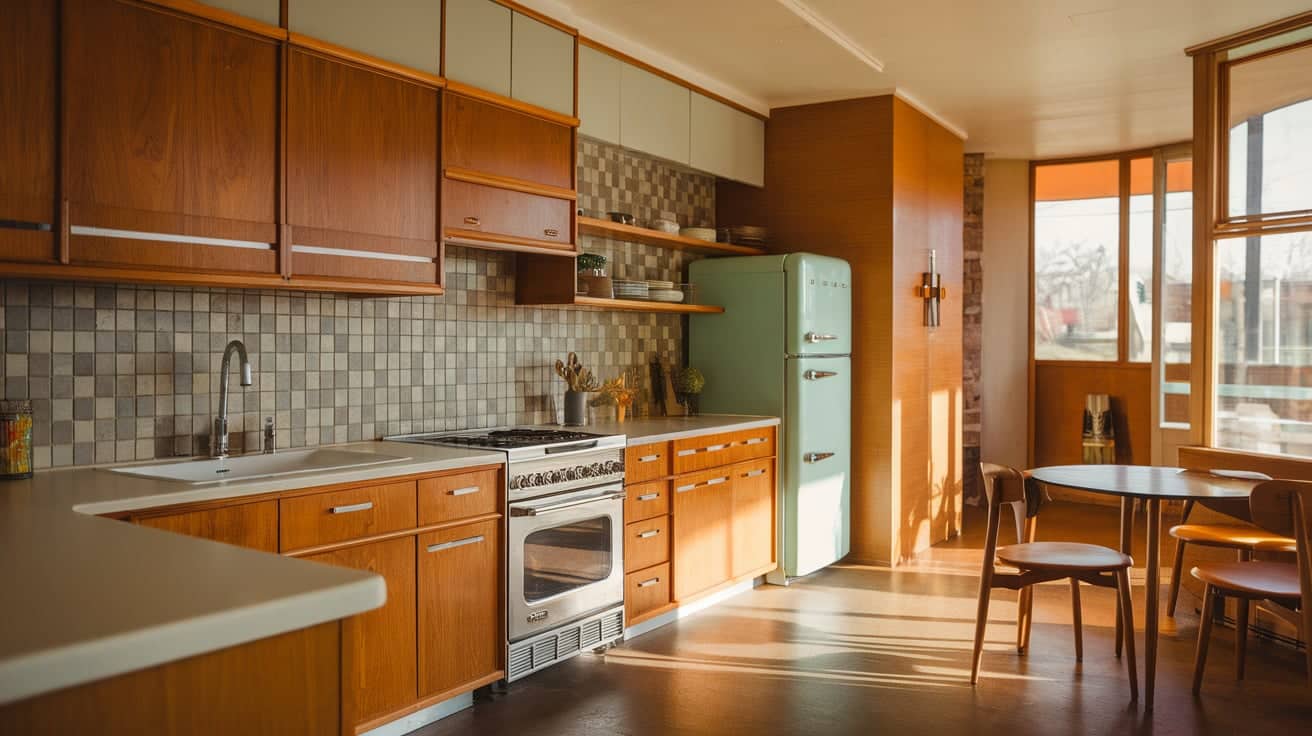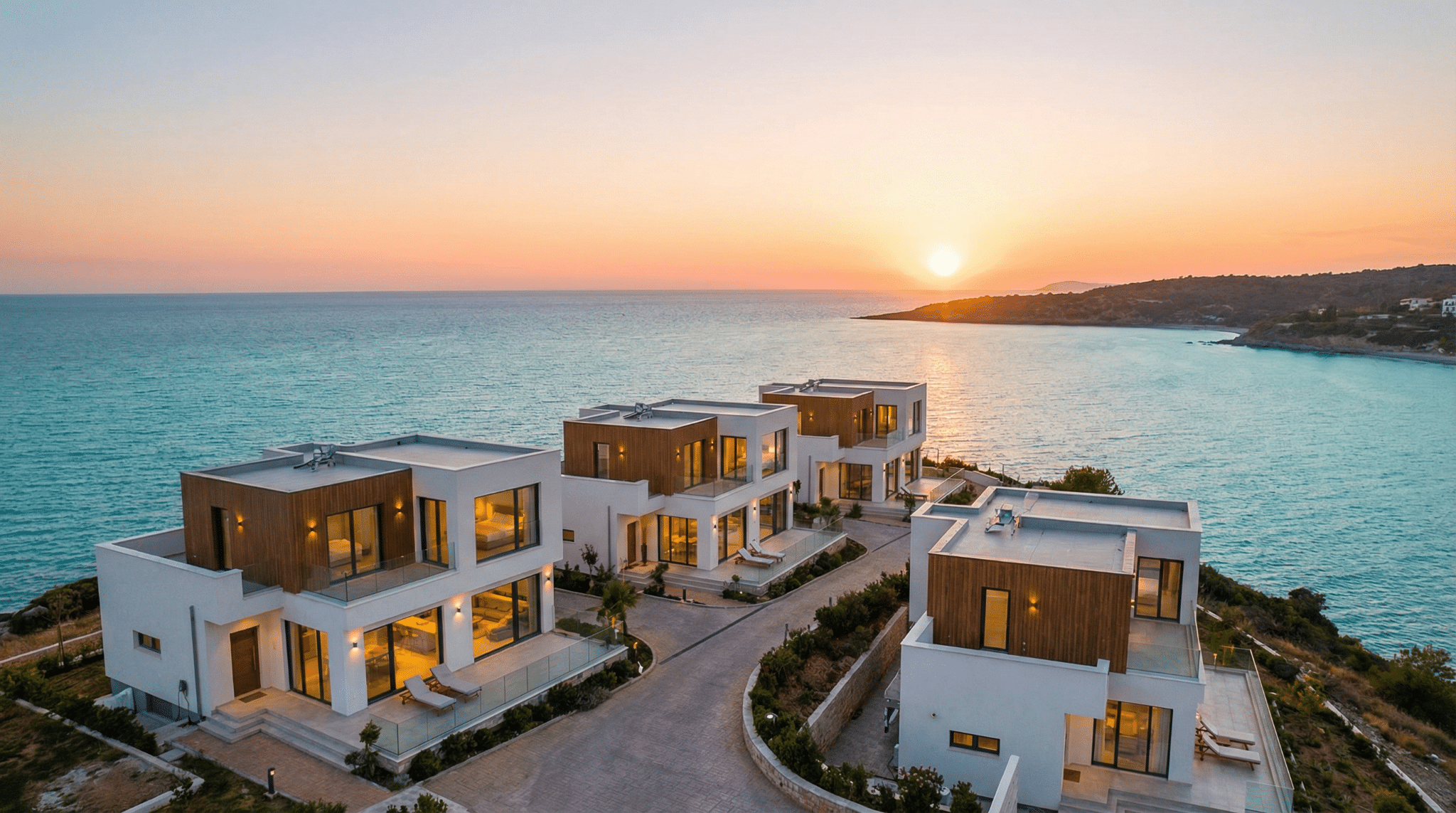Designing a kitchen that balances authenticity with functionality can feel overwhelming, especially when you’re drawn to the clean lines and organic forms of mid-century modern design.
I understand the challenge of honoring this iconic style while creating a space that works for today’s living.
I’m going to show you how to capture the essence of an original mid-century kitchen without sacrificing modern convenience. The perfect balance lies in understanding which elements define the era and how they can be thoughtfully incorporated.
In this guide, I’ll explain the essential components of authentic mid-century kitchen design, from cabinet profiles and hardware to color palettes and materials that defined the period.
You’ll learn how to create a kitchen that feels both nostalgic and fresh.
The Evolution of The Mid-Century Kitchen Over Time
The mid-century kitchen has evolved remarkably since its 1950s origins. Initially designed as compact, efficient spaces featuring innovative materials like laminate and colorful appliances, these kitchens reflected post-war optimism and technological progress.
Through the decades, they fell out of favor during the ornate 80s and 90s before experiencing a powerful revival in the 2000s.
Today’s mid-century kitchens blend nostalgic aesthetics with modern functionality. Smart technology hides behind retro facades, energy-efficient appliances replace power-hungry originals, and durable contemporary materials mimic vintage looks without the maintenance headaches.
While maintaining signature elements like clean lines, warm woods, and geometric patterns, modern interpretations typically feature larger footprints and improved storage solutions to accommodate contemporary lifestyles.
4 Essential Elements of a Mid-Century Kitchen
When I renovated my kitchen in mid-century style, I found that these four elements make all the difference between “kind of retro” and authentically mid-century:
1. Wooden Cabinetry with Clean Lines
The heart of any mid-century kitchen is beautiful wood cabinetry with minimal fuss. Walnut and teak were stars of the era for good reason – their rich, warm tones create an inviting atmosphere that still feels modern today.
- Flat slab doors without decorative panels or ornate hardware
- Natural wood finishes that showcase beautiful grain patterns
- Horizontal orientation that creates a sense of flow around the room
2. Bold Color Palettes
Mid-century kitchens weren’t afraid of color! While today’s kitchens often play it safe with all-white everything, authentic mid-century spaces balanced neutral woods with energetic color pops.
- Mustard yellow brings warmth and optimism.
- Olive green connects to nature and the outdoors
- Teal blue adds a refreshing contrast to warm woods
3. Iconic Lighting Fixtures
Lighting in mid-century kitchens was never an afterthought; it was sculpture that also happened to provide light!
- Sputnik chandeliers with multiple arms extending from a central sphere
- Globe pendants in milk glass or frosted glass for soft diffused light
- Cone-shaped pendants that direct light precisely where needed
4. Retro Appliances
Appliances in mid-century kitchens were designed to be seen, not hidden – they proudly showcased the latest technology of their time.
- Rounded corners and curved fronts rather than sharp edges
- Chrome or brushed metal details that add subtle shine
- Bold colors instead of standard white or stainless
Functions of an Original Mid-Century Kitchen
1. Compact and Efficient Layout
Designed with the single cook in mind, mid-century kitchens maximized function in minimal space.
Work zones were arranged in triangular patterns between the sink, stove, and refrigerator, reducing unnecessary steps while preparing meals.
2. Built-In Appliances
Refrigerators, ovens, and cooktops were often integrated directly into cabinetry, creating a seamless appearance.
This space-saving approach eliminated gaps between appliances and cabinets, making cleaning easier while achieving that coveted streamlined modern aesthetic.
3. Pass-Through Windows
These clever openings between the kitchen and dining areas allowed the cook to serve food without constantly walking around.
They maintained a connection between spaces while keeping the cooking mess visually separated from the dining areas.
4. Breakfast Nooks
These cozy built-in seating areas, paired with small tables, maximize dining space in compact kitchens.
Often featuring bench seating with storage underneath, they created multi-functional spots for casual meals, coffee breaks, and socializing.
5. Colorful Appliances
Unlike today’s stainless steel trend, mid-century kitchens embraced appliances in bold colors like turquoise, pink, and harvest gold.
These statement pieces added personality and coordinated with the overall kitchen color schemes.
How to Achieve an Authentic Mid-Century Kitchen Today?
Creating a mid-century kitchen that feels both authentic and functional doesn’t have to break the bank or sacrifice modern conveniences. Here’s my straightforward guide to bringing this timeless style into your home:
1. Finding the Right Balance
-
Start with Research: Browse magazines like Atomic Ranch, old Sears catalogs, and pinterest boards dedicated to original mid-century kitchens to identify elements you love.
-
Focus on One Statement Piece: Instead of gutting everything, build your design around a standout element, such as vintage cabinets or A classic pendant light.
-
Mix Old and New Thoughtfully: combine authentic vintage pieces (like a Formica table) with modern necessities (like an energy-efficient refrigerator with retro styling).
2. Sourcing Authentic Materials
-
Check salvage yards and specialty dealers for original cabinets, hardware, and lighting fixtures. Places like Rejuvenation and Moonshine Lamp and Shade offer authentic reproductions.
-
Look for laminate countertops from companies like Wilsonart and Formica that have reintroduced classic patterns like “boomerang” and “cracked ice.”
-
Search estate sales in mid-century neighborhoods for unexpected treasures like cabinet hardware, light fixtures, or even appliances that Can Be restored.
3. Quick and Simple Ways to Mid-Century Charm
-
Refinish Rather than Replace: Solid wood cabinets Can Be sanded and refinished to restore their original beauty at A fraction of replacement cost.
-
Update Cabinet Hardware: simple metal pulls in brushed brass or chrome instantly transform ordinary cabinets with mid-century flair.
-
Add Geometric Backsplash Tile: Creating a focal wall with simple square or hexagonal tiles in A classic mid-century color adds authentic character.
-
Paint Strategically: A single accent wall in mustard yellow or teal can establish the mid-century vibe without overwhelming the space.
Conclusion
Creating an authentic mid-century kitchen isn’t just about following design trends; it’s about honoring a time when form and function worked together beautifully. Focusing on warm wood cabinets, clean horizontal lines, and thoughtful pops of color can capture the spirit of this timeless style.
Remember that the most successful mid-century kitchens balance the best of both worlds: vintage charm with modern practicality.
If a complete renovation isn’t possible, start small with period-appropriate hardware or lighting fixtures.
Ready to take the next step? Check out local salvage yards for authentic materials or browse my collection of mid-century kitchen inspiration photos.
Frequently Asked Questions
1. What Were the Two Hallmarks of A 1950s Kitchen?
Two hallmarks of A 1950s kitchen were colorful appliances in shades like turquoise and harvest gold and horizontal wood cabinets with clean lines that showcased natural grain patterns.
2. What Was the Typical Kitchen in The 1950s?
The typical 1950s kitchen featured pastel colors, linoleum floors, chrome appliances, and Formica countertops. It focused on functionality, with built-in cabinets, a separate dining area, and easy-to-clean surfaces.
3. What Kitchen Style Never Goes out Of Style?
The classic farmhouse kitchen never goes out of style. Its timeless appeal comes from rustic wood, neutral colors, functional design, and a cozy, welcoming atmosphere that suits any home.












